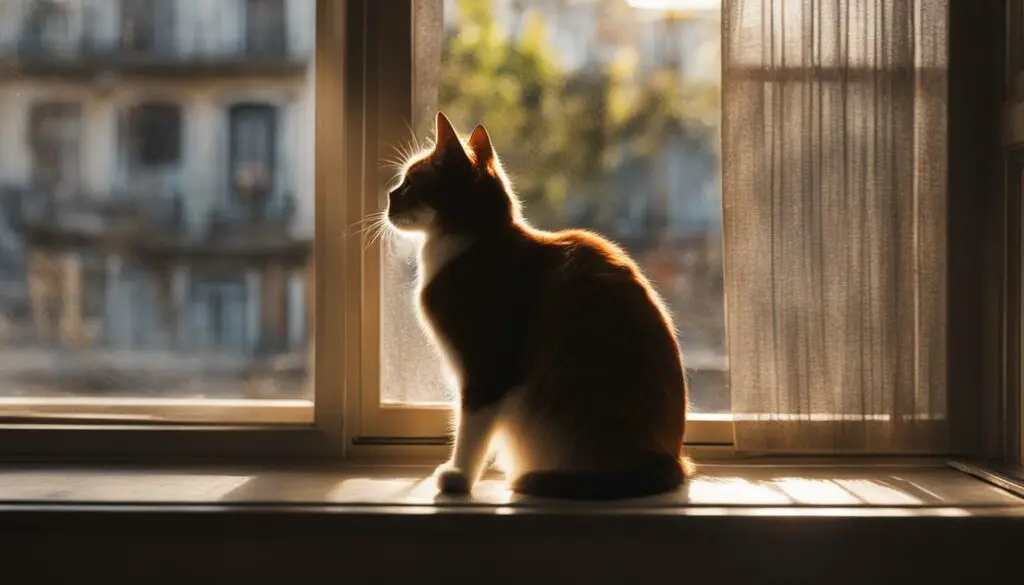Moving can be a stressful experience for cats, and one common behavior that may arise is excessive meowing. Cats meow to communicate, and the unfamiliar environment and changes in routine can trigger anxiety and insecurity, leading to increased vocalization. Understanding the reasons behind this behavior and implementing strategies to help your cat adjust can alleviate their stress and promote a smoother transition into their new home.
Key Takeaways:
- Excessive meowing after moving can indicate stress and discomfort in cats.
- Cats meow to communicate their needs, desires, and emotions.
- Factors contributing to excessive meowing include separation anxiety, unfamiliar environment, and changes in routine.
- Understanding the cat’s perspective and addressing their triggers can help create a more secure and comforting environment.
- Calming strategies, routine establishment, and socialization can assist in reducing excessive meowing.
Understanding Cat Behavior and Communication
When it comes to cat behavior, meowing is a key form of communication. Cats use meows to express their needs, desires, and even to greet their owners. However, excessive meowing after moving can be a sign of heightened stress or discomfort in your cat. It’s important to observe their behavior and consider other factors that may be contributing to their vocalization. Loneliness, fear, and insecurity can all play a role in excessive meowing.
As cat owners, it’s crucial to understand the various reasons why cats meow excessively. By recognizing their behavior as a form of communication, we can better address their needs and ensure their well-being. However, when it comes to moving to a new environment, cats can experience heightened anxiety and insecurity, leading to increased vocalization.
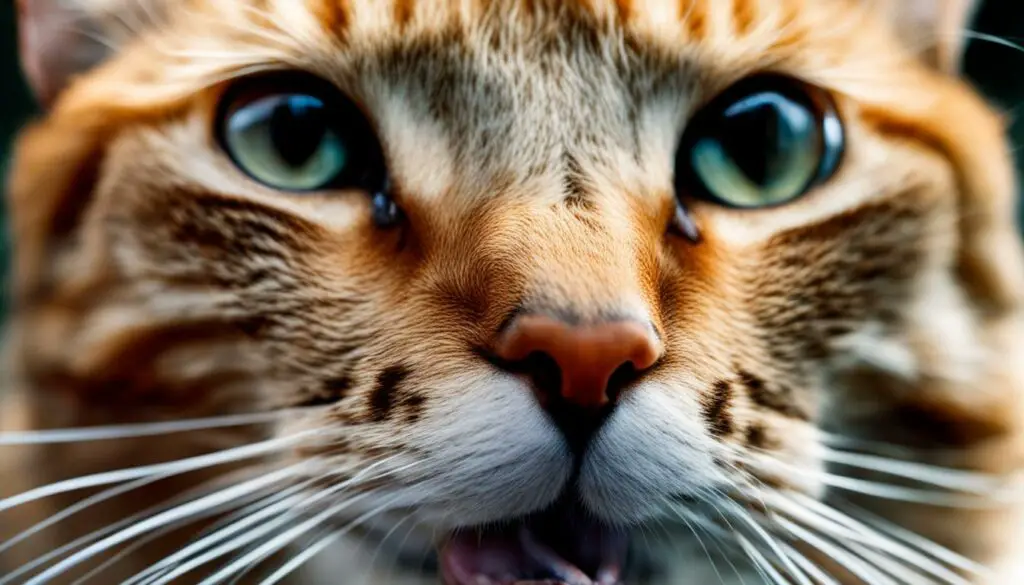
Understanding Cat Vocalizations
Meowing is just one of the many vocalizations that cats use to communicate with their owners. By paying attention to the tone, volume, and frequency of their meows, we can gain insight into their emotions and needs. It’s important to note that excessive meowing after moving should not be ignored, as it can indicate a need for attention or a deeper underlying issue.
By taking the time to understand your cat’s behavior and communication style, you can provide them with the support they need to adjust to their new environment. This includes addressing their fears and insecurities, implementing calming strategies, and creating a secure and comforting space for them. Remember, patience and understanding are key when helping your cat navigate through the challenges of moving and settling into their new home.
Factors Contributing to Excessive Meowing
When a cat moves to a new environment, they may experience various factors that contribute to excessive meowing. Understanding these factors can help us better address their needs and create a more comfortable living space for them. Let’s explore some of the common factors that can lead to increased vocalization in cats after a move.
Separation Anxiety:
Separation anxiety is a common issue for cats when they are separated from their familiar surroundings or their owners. The stress of the unfamiliar environment and the absence of their usual routines can trigger excessive meowing as a way for them to express their anxiety and seek comfort. Providing them with a safe space, familiar objects, and reassurance can help alleviate their separation anxiety and reduce their vocalization.
Adaptation to an Unfamiliar Environment:
Moving to a new environment can be overwhelming for cats. The unfamiliar sights, sounds, and smells can contribute to their stress and insecurity, leading to increased meowing. Gradually introducing them to their new surroundings, providing hiding spots, and creating a calm and consistent routine can help them adapt more easily and reduce their vocalization.
Noise in the New Environment:
The noise level in the new environment can also affect a cat’s meowing behavior. Loud noises, such as traffic outside or construction work nearby, can cause them to feel on edge and anxious, leading to excessive vocalization. Creating a quiet and peaceful space for them, using sound-absorbing materials, or providing white noise can help reduce their stress and minimize their meowing.
Changes in Routine and the Presence of New People or Pets:
Cats are creatures of habit, and any changes in their routines can cause them to feel unsettled. Additionally, the presence of new people or pets in their new environment can trigger anxiety and increased vocalization. Maintaining a consistent routine and gradually introducing new individuals or pets can help them adjust more smoothly and decrease their meowing.
| Factors Contributing to Excessive Meowing | Description |
|---|---|
| Separation Anxiety | The stress of being separated from familiar surroundings or owners can lead to excessive meowing. |
| Adaptation to an Unfamiliar Environment | The unfamiliar sights, sounds, and smells in a new environment can cause stress and increased vocalization. |
| Noise in the New Environment | Loud noises in the new environment can make cats feel anxious and contribute to excessive meowing. |
| Changes in Routine and the Presence of New People or Pets | Changes in routine and the introduction of new individuals or pets can cause cats to feel unsettled and meow more frequently. |
Understanding the Cat’s Perspective
When it comes to excessive meowing after a move, it’s crucial to understand the cat’s perspective. Moving to a new environment can be a frightening experience for cats, leading to feelings of fear and insecurity. This can manifest as increased vocalization as they try to communicate their discomfort.
It’s essential to take into account any triggers that may be causing fear or anxiety in your cat. Common triggers include unfamiliar surroundings, loud noises, and changes in routine. By identifying these triggers, you can create a more soothing and secure environment for your cat to help alleviate their meowing.
In some cases, excessive meowing can also be a sign of underlying health issues. It’s important to consult with a veterinarian to rule out any medical conditions that may be contributing to the behavior. By addressing any health concerns, you can ensure that your cat receives the appropriate treatment and support.
Remember, each cat is unique, and their adjustment period may vary. Patience and understanding are key during this time as they acclimate to their new surroundings. By empathizing with your cat’s perspective and taking appropriate measures to provide comfort and reassurance, you can help them settle into their new home and reduce their excessive meowing.
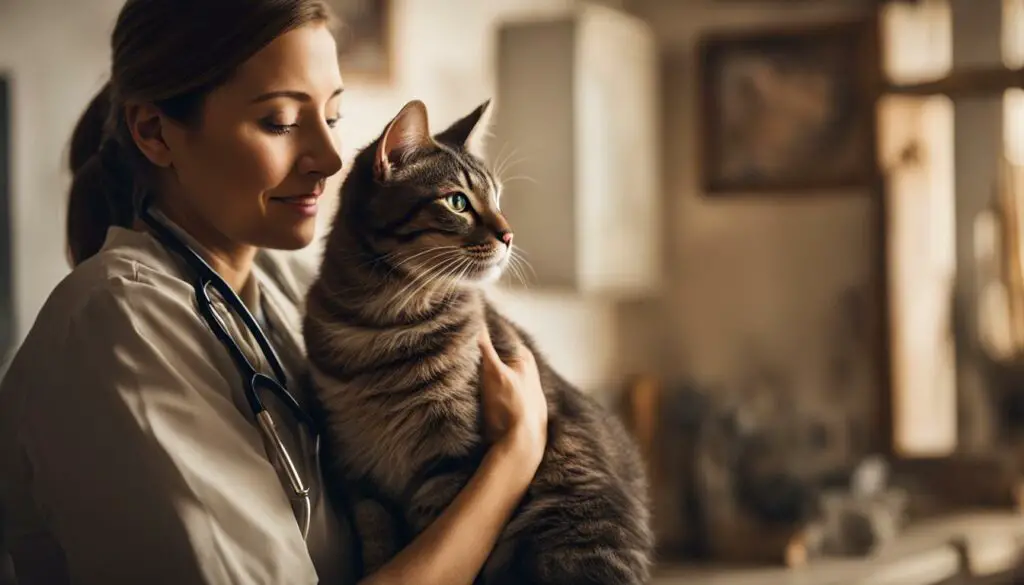
Calming Strategies for Your Cat
When your cat is meowing excessively after a move, it’s important to implement calming strategies to help them adjust to their new environment. Patience and understanding are key in this process, as it may take time for your cat to acclimate. By providing a calm and consistent routine, creating a safe and comfortable space for them, and bonding through gentle interactions, you can help alleviate their stress and reduce their meowing.
To calm your cat, start by establishing a calm and consistent routine. Cats thrive on routine, and having a predictable schedule can help them feel secure in their new surroundings. Feed them at the same times each day, and create a consistent playtime routine. This will provide them with a sense of stability and reduce their anxiety.
Creating a safe and comfortable space is also essential in calming your cat. Set up a designated area for them with familiar objects and scents, such as their bed, toys, and a scratching post. This will help them feel more secure and decrease their meowing. Additionally, consider using pheromone diffusers or sprays, which can help create a sense of familiarity and calmness in their new environment.
“When your cat is meowing excessively after a move, it’s important to implement calming strategies to help them adjust to their new environment.”
Bonding with your cat through gentle and reassuring interactions is another effective way to calm them. Spend quality time with your cat, engaging in activities they enjoy, such as playing or grooming. This will help them feel more at ease and reduce their meowing. It’s important to approach your cat with patience and understanding, allowing them to come to you on their terms and never forcing interaction.
| Calming Strategies for Your Cat | Description |
|---|---|
| Establish a calm and consistent routine | Provide a predictable schedule for feeding and playtime to create a sense of stability |
| Create a safe and comfortable space | Set up a designated area with familiar objects and scents to help your cat feel secure |
| Bond through gentle interactions | Spend quality time with your cat, engaging in activities they enjoy to build trust and reduce anxiety |
Implementing these calming strategies will help your cat adjust to their new environment and reduce their excessive meowing. Remember to be patient and understanding throughout the process, as it may take time for your cat to fully settle in. By providing a calm and secure environment, establishing a routine, and bonding with your cat, you can help them feel more at ease and promote a smoother transition into their new home.
Establishing a Routine and Socialization
When helping your cat adjust to a new environment, establishing a consistent routine and incorporating socialization activities are key. Following a regular schedule can provide your cat with a sense of security and predictability, which can help reduce their meowing. Try to feed them at the same time each day and provide play and exercise sessions at specific times to create a structured routine.
Additionally, socialization plays a vital role in helping your cat feel more comfortable in their new home. Gradually introduce them to new people and pets in a controlled and positive manner. Start with short, supervised interactions and gradually increase the duration and complexity of their social interactions. This process allows your cat to adjust at their own pace and feel more confident in their surroundings.
Incorporating playtime into your cat’s routine is also essential. Regular play sessions provide mental and physical stimulation, which can help them release energy and reduce their meowing. Use interactive toys, such as wand toys or puzzle feeders, to engage your cat in mentally stimulating activities. This not only distracts them from excessive vocalization but also promotes a positive adjustment to their new environment.
| Benefits of Routine and Socialization | How to Implement |
|---|---|
| Reduces stress and anxiety | Stick to a consistent schedule for feeding and playtime |
| Promotes a sense of security and familiarity | Introduce new people and pets gradually |
| Provides mental and physical stimulation | Use interactive toys during play sessions |
| Helps redirect their focus from excessive meowing | Engage in regular play and exercise sessions |
By establishing a routine and incorporating socialization into your cat’s daily life, you can help them feel more secure and reduce their meowing. Remember to be patient and give them time to adjust to their new surroundings. With consistent efforts and positive interactions, your cat will gradually become more comfortable and will meow less frequently.
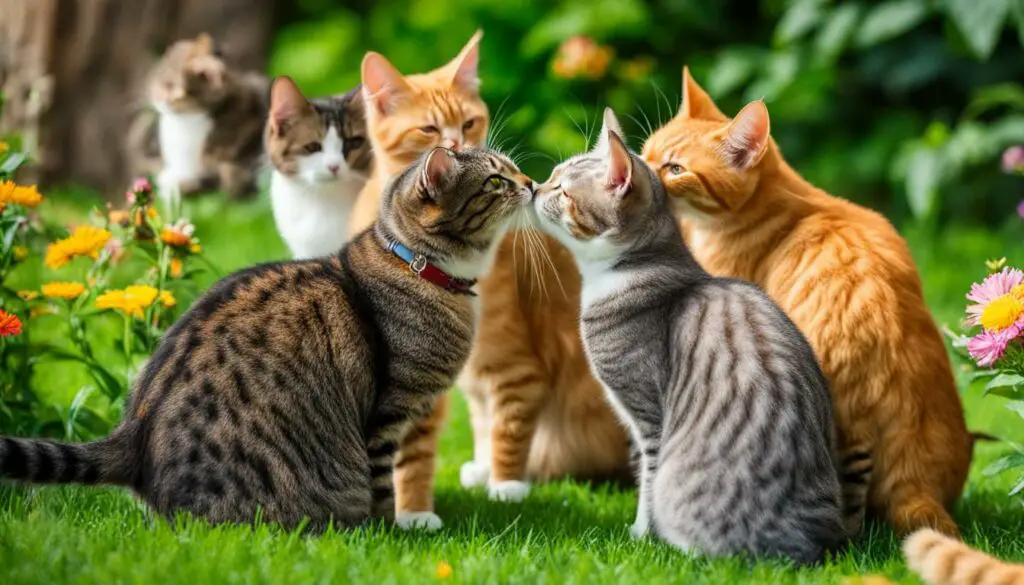
Addressing Territory and Marking Behaviors
When cats move to a new environment, their sense of territory and ownership can be disrupted, leading to excessive meowing. To help them establish their territory and reduce vocalization, it’s important to provide appropriate scratching posts and marking surfaces. These designated areas allow cats to leave their scent and mark their territory, helping them feel more secure in their new surroundings.
“Providing appropriate scratching posts and marking surfaces can help cats establish their territory and reduce excessive meowing.”
– Cat Behavior Expert
Furthermore, using pheromone-based products or products that mimic the scent of familiar objects can also help create a sense of familiarity and comfort for cats in their new environment. Such products can help alleviate their anxiety and reduce the urge to meow excessively. By providing these resources, you are helping your cat feel more secure and confident in their territory.
Table: Providing Territory and Marking Solutions for Cats
| Strategy | Description |
|---|---|
| Scratching Posts | Provide multiple scratching posts in different areas of the house to allow your cat to mark their territory through scratching. |
| Marking Surfaces | Set up designated marking surfaces, such as vertical scratchers or sisal mats, where your cat can leave their scent and mark their territory. |
| Pheromone Diffusers | Use pheromone diffusers that release calming scents to help create a sense of familiarity and security for your cat in their new environment. |
| Mimicking Familiar Scents | Place familiar objects, such as blankets or bedding with your cat’s scent, in different areas of the house to provide them with a comforting and familiar smell. |
By addressing territory and marking behaviors, you are helping your cat feel more settled and secure in their new home, reducing their excessive meowing and promoting a smoother transition.
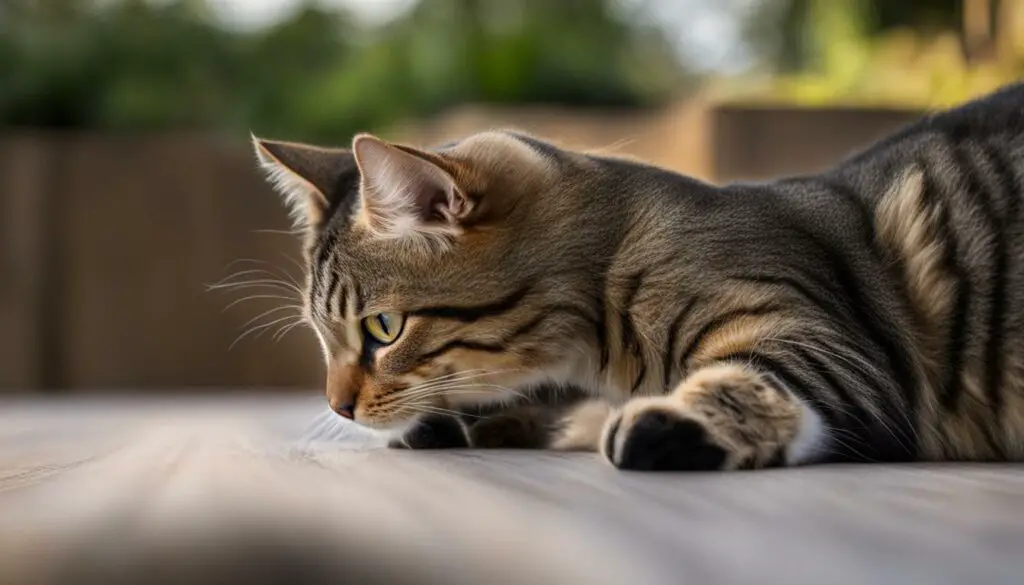
Grooming and Comforting Your Cat
When a cat is feeling stressed or anxious after a move, providing grooming and comfort can be beneficial for their overall well-being. Grooming not only helps keep your cat’s fur clean and healthy, but it also serves as a comforting activity that helps them relax. Spending time brushing or petting your cat can provide them with reassurance and reduce their stress. The act of grooming releases endorphins, which can promote a sense of calm and relaxation. Additionally, grooming helps strengthen the bond between you and your cat, creating a sense of security and trust.
Creating a comforting environment is also important for helping your cat adjust after a move. Providing hiding spots, such as covered beds or cat condos, can give your cat a sense of security and privacy. Cats often seek out secluded areas when they feel overwhelmed or anxious, so having hiding spots available allows them to retreat to a safe space when needed. You can further enhance their comfort by adding familiar objects, such as their favorite blanket or toy, to these hiding spots. These familiar scents and objects can help create a sense of familiarity and reduce their meowing.
| Grooming and Comfort Techniques | Benefits |
|---|---|
| Brushing your cat’s fur regularly | Removes dirt and tangles, stimulates blood flow, and promotes relaxation |
| Petting and stroking your cat | Creates a sense of reassurance, releases endorphins, and strengthens the bond between you and your cat |
| Providing hiding spots | Gives your cat a sense of security and privacy, allowing them to retreat to a safe space |
| Adding familiar objects to hiding spots | Creates a sense of familiarity and reduces stress by having comforting scents and objects nearby |
“Grooming and comforting activities can play a crucial role in helping your cat feel safe and secure after a move. Taking the time to groom your cat and create a comforting environment can significantly reduce their stress levels and alleviate excessive meowing.”
In addition to grooming and creating a comforting environment, providing plenty of love and attention to your cat is essential. Engaging in gentle and reassuring interactions, such as playing and petting, can help them feel more at ease and decrease their meowing. It’s important to remember that each cat is unique, so it’s crucial to understand your cat’s preferences and tailor the grooming and comforting techniques to their individual needs. By providing a calm and comforting space for your cat and engaging in bonding activities, you can help them adjust to their new environment and reduce their excessive meowing.

Recognizing and Managing Separation Anxiety
Adjusting to a new environment can be particularly challenging for cats, leading to separation anxiety and excessive meowing. To help your feline friend settle in, it’s crucial to recognize and address this anxiety. Separation anxiety occurs when cats feel distressed due to being separated from their familiar surroundings or their owners.
One effective way to manage separation anxiety is through gradual introductions to the new space. Start by confining your cat to a small area with familiar scents and objects, gradually expanding their access to the rest of the house. This step-by-step approach helps them feel more secure and reduces their anxiety.
Another strategy is to implement gradual departures and returns. Start by leaving your cat alone for short periods and gradually increase the duration over time. Leaving interactive toys or puzzles can help distract and entertain them while you’re away, reducing their meowing and helping them adjust to being alone.
H3: Distraction Techniques
Distraction techniques can also be effective in managing separation anxiety. Providing interactive toys, such as treat-dispensing puzzles or feather wands, can keep your cat engaged and mentally stimulated. This can redirect their focus from their anxiety and meowing to more positive activities.
Additionally, creating a routine that includes playtime and mental stimulation can help your cat settle in and feel more at ease. Engaging in interactive play sessions not only provides physical exercise but also strengthens the bond between you and your cat. Regular playtime can reduce their anxiety, decrease excessive meowing, and promote a more positive adjustment to their new environment.
| Recognizing and Managing Separation Anxiety |
|---|
| Recognize signs of separation anxiety, such as excessive meowing and clinginess |
| Gradually introduce your cat to the new environment to alleviate anxiety |
| Implement gradual departures and returns to help them adjust to being alone |
| Use distraction techniques, such as interactive toys, to redirect their focus |
| Engage in regular playtime to strengthen their bond and reduce anxiety |
Veterinary Support and Health Considerations
When dealing with a cat that is meowing excessively after a move, it is important to consider their overall health and wellbeing. Consulting with a veterinarian can help rule out any underlying medical issues that may be contributing to the behavior. Certain conditions, such as urinary tract infections or thyroid disorders, can lead to increased vocalization in cats. By addressing these health concerns, you can effectively manage your cat’s meowing and ensure their overall well-being.
In addition to medical support, understanding the triggers that cause fear or insecurity in your cat can also help create a more comfortable environment for them. Cats may experience heightened anxiety in unfamiliar surroundings, leading to excessive meowing. By identifying these triggers, such as loud noises or changes in routine, you can make necessary adjustments to help alleviate your cat’s stress and reduce their vocalization.
It is important to note that moving to a new environment can be a challenging process for cats, and their meowing may be a natural response to the unfamiliarity and changes in routine. Providing them with a comforting and secure space, along with plenty of mental and physical stimulation, can help them adjust more easily. By incorporating environmental enrichment, such as interactive toys and scratching posts, you can help redirect their focus and alleviate anxiety.
Remember, when it comes to managing excessive meowing after a move, patience and understanding are key. Each cat is unique and may require different strategies to help them adjust. By working closely with a veterinarian and implementing appropriate measures, you can support your cat’s well-being and promote a smoother transition into their new home.
Veterinary Support and Health Considerations Table
| Health Concerns | Triggers | Environmental Enrichment |
|---|---|---|
| Consult with a veterinarian to rule out underlying medical issues | Identify triggers that cause fear or insecurity | Provide a comforting and secure space |
| Address conditions such as urinary tract infections or thyroid disorders | Make necessary adjustments to reduce stress | Incorporate interactive toys and scratching posts |
| – | Provide a calm and consistent environment | Offer mental and physical stimulation |
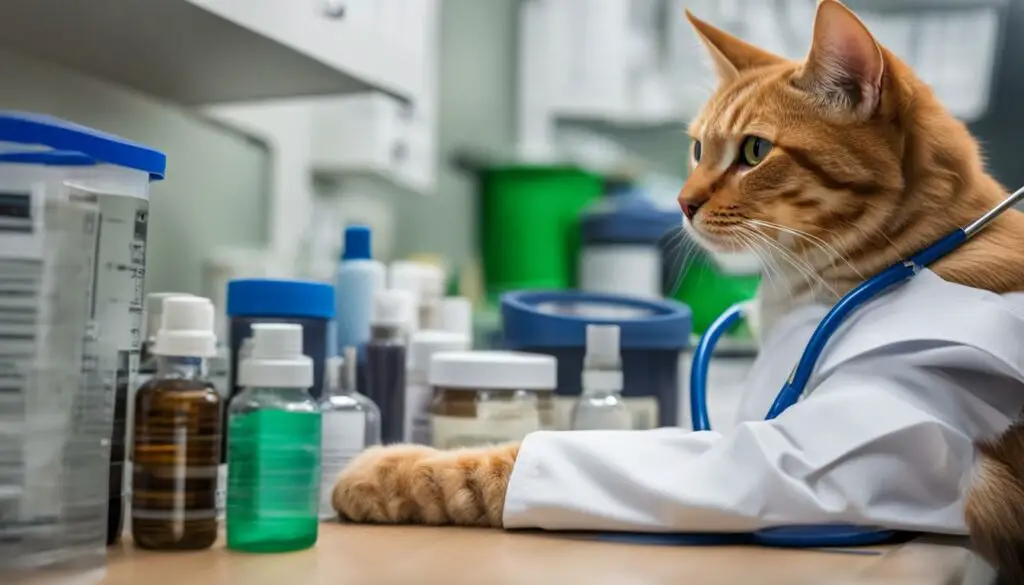
Environmental Enrichment and Distraction
Providing environmental enrichment is crucial in helping your cat adjust to their new environment and reduce excessive meowing. By offering a variety of toys and interactive activities, you can help distract your cat from stress triggers and keep them mentally stimulated.
One effective way to provide environmental enrichment is through interactive toys. These toys engage your cat’s natural instincts to hunt and play, offering mental and physical stimulation. Puzzle feeders or treat-dispensing toys can also keep your cat engaged and provide a source of entertainment.
In addition to toys, regular play sessions with your cat are essential. Engaging in interactive play not only helps redirect their focus but also helps in bonding with them. Use toys that stimulate their hunting instinct, such as wand toys or toys that mimic prey movements. Play sessions also provide an outlet for excess energy, reducing their meowing and promoting a positive adjustment to their new environment.
| Benefits of Environmental Enrichment and Distraction for Cats |
|---|
| 1. Mental stimulation and alleviation of boredom |
| 2. Reduces stress and anxiety |
| 3. Redirection of their focus from triggers that cause excessive meowing |
| 4. Promotes physical exercise and prevents obesity |
Remember, each cat has different preferences, so experiment with different types of toys to discover what your cat enjoys the most. It’s important to rotate toys regularly to maintain their interest. Additionally, provide scratching posts and climbing structures to fulfill their natural instincts and help them feel more secure in their new territory.

Distraction Techniques to Reduce Excessive Meowing
Aside from toys, other distraction techniques can help redirect your cat’s attention and decrease their meowing. Some helpful techniques include:
- Playing calming music or ambient sounds to create a soothing environment
- Providing hiding spots, such as covered beds or boxes, for your cat to retreat to when they feel anxious or overwhelmed
- Using interactive puzzle toys or treat-dispensing toys to keep them mentally engaged and focused on the task at hand
- Engaging in training sessions to stimulate their minds and reinforce positive behaviors
By implementing these environmental enrichment and distraction strategies, you can help your cat adapt to their new surroundings and reduce their meowing. Remember to be patient and consistent in your approach to give them the time they need to settle in and feel secure.
Using Calming Products and Techniques
When it comes to helping your cat adjust to their new environment and reduce excessive meowing, there are various calming products and techniques that can be beneficial. These resources can help alleviate stress and create a sense of calm for your furry friend. Here are some options to consider:
1. Pheromone Diffusers:
Pheromone diffusers release synthetic feline pheromones that help create a sense of security and familiarity for your cat. These pheromones mimic the natural scent markings that cats use to communicate and feel safe in their surroundings. By using a diffuser in your new home, you can help your cat feel more settled and reduce their meowing.
2. Herbal Remedies:
Herbal remedies, such as chamomile or valerian root, can have calming effects on cats. These natural remedies can be administered in various forms, including treats, sprays, or supplements. However, it’s important to consult with your veterinarian before introducing any herbal remedies to ensure they are safe and appropriate for your cat’s specific needs.
3. Calming Music:
Just as music can have a relaxing effect on humans, it can also help calm cats. There are specially designed playlists and albums available that feature soothing melodies and frequencies that are pleasing to feline ears. Playing calming music in the background can help create a peaceful atmosphere and reduce your cat’s stress levels.
Remember, every cat is unique, and what works for one may not work for another. It’s essential to observe your cat’s response to these calming products and techniques and make adjustments accordingly. Additionally, consulting with your veterinarian or a cat behaviorist can provide valuable guidance and ensure you’re implementing the most suitable options for your cat’s specific needs.
The Importance of Patience and Understanding
When it comes to helping your cat adjust to their new environment, patience and understanding are key. Moving can be a stressful experience for cats, and their excessive meowing is often a manifestation of their anxiety and discomfort. It’s important to remember that this behavior is their way of communicating their needs and emotions to you.
Instead of scolding or punishing your cat for their meowing, offer them reassurance and comfort. Be patient as they acclimate to their new surroundings and understand that it may take time for their vocalization to decrease. Provide them with a calm and consistent routine, offer familiar objects and scents, and engage in gentle and reassuring interactions.
Creating a secure and comforting environment for your cat will help alleviate their stress and promote a smoother adjustment. Avoiding loud noises, providing hiding spots, and gradually introducing them to new people and pets can also help reduce their meowing. Remember, each cat is unique, and what works for one may not work for another. Patience and understanding are essential as you navigate this transition together.
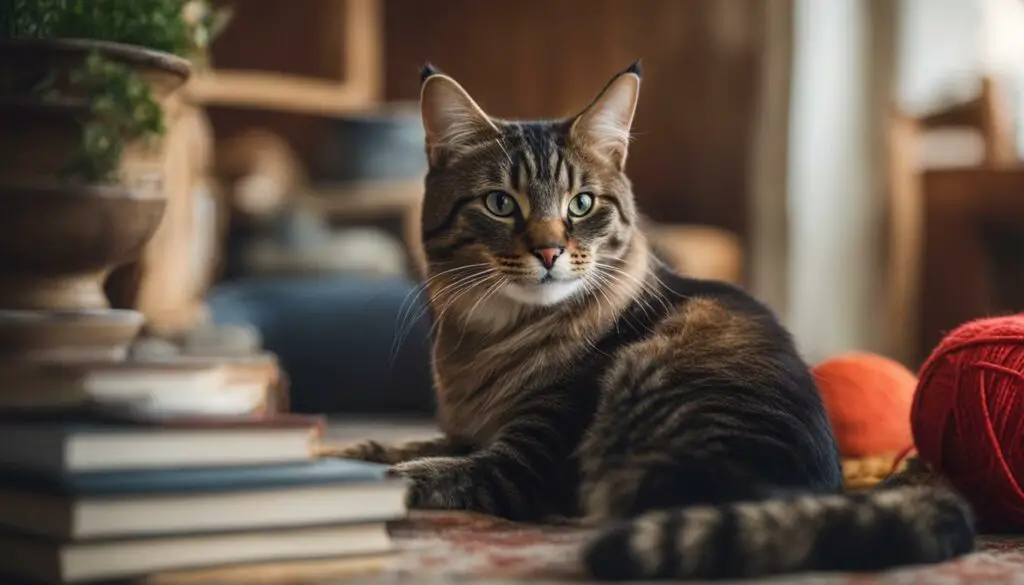
Table: Strategies for Helping Your Cat Adjust to a New Environment
| Strategies | Description |
|---|---|
| Provide a calm and consistent routine | Establish a predictable schedule for feeding, playtime, and rest, helping your cat feel secure in their new home. |
| Create a safe and comfortable space | Offer a designated area with familiar objects, such as blankets or toys, where your cat can retreat when they feel overwhelmed. |
| Bond through gentle interactions | Engage in activities like grooming, playing, and cuddling to strengthen your bond and provide reassurance to your cat. |
| Gradually introduce new elements | Introduce new people, pets, or areas of the home slowly and in a controlled manner to reduce your cat’s anxiety. |
| Seek veterinary guidance | If your cat’s meowing persists or escalates, consult with a veterinarian to rule out any underlying health issues or recommend additional strategies. |
Building a Strong Bond with Your Cat
Building a strong bond with your cat is essential for their well-being and can help reduce excessive meowing. By investing time and effort into developing a deep connection, you can create a safe and trusting environment that promotes a sense of security for your feline friend. Here are some strategies to strengthen the bond with your cat:
1. Socialization:
Socializing your cat is crucial for building trust and confidence. Gradually introduce them to new people, pets, and environments in a controlled and positive manner. Encourage gentle interactions and provide plenty of rewards, such as treats or playtime, to associate socialization with positive experiences.
2. Establish a Routine:
Cats thrive on routine, and having consistent daily activities can make them feel secure and reduce meowing. Establish a regular feeding, play, and sleep schedule that aligns with your cat’s natural instincts. Providing structure and predictability in their daily lives can help them feel more settled and build trust.
3. Play and Interact:
Engaging in regular play sessions with your cat is not only a fun bonding activity but also provides mental and physical stimulation. Use interactive toys and engage in activities that mimic hunting behaviors, such as chasing and pouncing. This helps fulfill their natural instincts and strengthens the bond between you and your cat.
Remember, building a strong bond takes time, patience, and understanding. Each cat is unique, so tailor your approach to their individual preferences and personality. By investing in your cat’s emotional well-being and creating a loving and secure environment, you can reduce their meowing and foster a deep and rewarding connection.

Table: Strategies for Building a Strong Bond with Your Cat
| Strategy | Description |
|---|---|
| Socialization | Gradually introduce your cat to new people, pets, and environments in a positive and controlled manner. |
| Establish a Routine | Provide a consistent daily schedule for feeding, playtime, and sleep to create a sense of security. |
| Play and Interact | Engage in regular play sessions using interactive toys to stimulate your cat’s mental and physical well-being. |
Conclusion
Helping your cat adjust to their new environment after a move can alleviate their stress and reduce excessive meowing. Understanding the reasons behind their behavior, such as anxiety and insecurity, is crucial in providing the support they need. By observing their behavior and implementing calming strategies, such as creating a consistent routine and providing a safe space, you can help your cat settle into their new home.
Patience and understanding are key during this adjustment period. Avoid punishing or scolding your cat for meowing, as this can increase their stress. Instead, focus on building a strong bond through gentle interactions and play, reinforcing positive behavior, and celebrating small successes.
Consulting with a veterinarian is important to rule out any underlying health issues and to receive guidance on managing your cat’s meowing. Remember, as your cat settles into their new home, their meowing should gradually decrease. With time, patience, and understanding, your cat will adjust and feel more secure in their new environment.
FAQ
Why is my cat meowing a lot after moving?
Moving can be a stressful experience for cats, and one common behavior that may arise is excessive meowing. Cats meow to communicate, and the unfamiliar environment and changes in routine can trigger anxiety and insecurity, leading to increased vocalization.
How can I help my cat adjust to their new home?
Patience and understanding are key when helping your cat adjust to their new environment. Providing a calm and consistent routine, creating a safe and comfortable space for them, and bonding through gentle interactions can help alleviate their stress and promote a smoother transition.
Is excessive meowing after moving a sign of health issues?
Excessive meowing can be a sign of underlying health issues, such as urinary tract infections or thyroid disorders. It’s important to consult with a veterinarian to rule out any medical conditions that may be contributing to your cat’s behavior.
How can I reduce my cat’s stress and meowing?
There are various strategies you can try, such as providing environmental enrichment, engaging in play and interactive activities, and using calming products or techniques. Consulting with a veterinarian or cat behaviorist can help determine the best approach for your cat’s specific needs.
How long does it take for a cat to adjust to a new environment?
The adjustment period can vary for each cat. It may take a few weeks or even months for your cat to fully settle into their new home. Patience, understanding, and providing a secure and comforting environment are key during this transition.
Will punishing my cat for excessive meowing help?
Punishing or scolding your cat for excessive meowing can increase their stress and make the adjustment period more difficult. It’s important to provide reassurance and comfort instead, and celebrate small successes as they settle into their new home.

